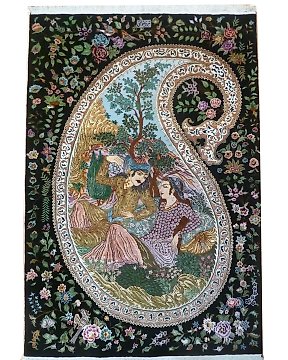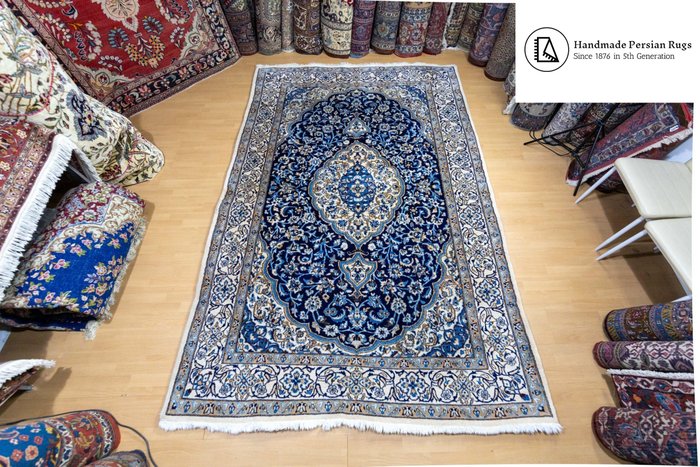
Tabriz 60 Rag Signed - Matto - 157 cm - 105 cm
Nro. 82945415

Nro. 82945415

Knot density: 12La (12 yarn layers), approx. 250.000 knots/sqm
Pattern: Lachak Toranj Nain Medallion
Origin: City of Nain, Iran
Condition: Very good with minimal patina, extensively restored, professionally washed
Material: pile 100% - warp 100% cotton
Nain carpets
Nain rugs differ from most other types of Persian rugs in that they are made of pressed cotton warps and two cotton wefts.
Nain rugs are hand knotted with asymmetric Persian knots and a pile of wool and silk on a cotton warp. The rugs are then closely trimmed to better show off the pattern.
The town of Nain is known around the world for producing some of the finest handmade carpets. The special thing about the Nain carpets is the high percentage of silk that is used for the production of the carpets.
In addition to the high quality of the material itself, the designs and color combinations that the weavers use for their rugs are simply magnificent.
The city of Nain
Nain is a small town in the center of Iran, just a few kilometers away from the other famous carpet producing town Isfahan .
Interestingly, Nain was in contrast to the other carpet producing cities of Iran historical never seen a town where carpets were made. Before the 20th century, the city was better known worldwide for the production of high quality handmade woolen cloth.
However, when this business declined for various reasons at the beginning of the 20th century, the authorities began to focus on carpet manufacture. Initially, they had their carpets woven by weavers from the nearby city of Isfahan.
This is one of the reasons why when you look at contemporary Nain rugs you will find that many of these rugs share several similar design elements to Isfahan rugs.
However, despite these similarities, it is not too difficult to distinguish a Nain rug as they retain their unique color and design characteristics.
This is because when the local tribes in Nain began weaving their own rugs, they incorporated their own personal style into their work, giving it some distinctive characteristics that make these rugs instantly recognizable.
No carpets Safavid design
The Nain rugs are inspired by Safavid design. During their reign between 1502 and 1722, the Safavid rulers brought about many changes in the patterns and designs of the carpets.
They set up schools, workshops and factories where Nain weavers were encouraged and taught to produce more sophisticated carpets with highly complex and intricate designs.
Safavid influence can be seen in the stylized medallions, floral designs, vines and mythical creatures found in the Nain carpets.
Some highly skilled master weavers even weave human figures into their designs.
LAA”, the fineness indicator of Nain carpets
LAA is a Farsi term meaning layers. In Nain rugs, it refers to the layers of the individual warp threads used to weave the rug. Since the excess length of the warp threads make up the fringes, the LAA can also be counted as the number of strands of yarn that make up a fringe.
The LAA is used to assess the quality of Nain carpets. A Nain rug with an LAA of 4 is considered the best.
Nain carpets with an LAA of 9 are also considered to be of good quality, but they are the worst quality among Nain carpets. This speaks volumes about the high quality of Nain rugs in general.
Construction of Nainoriental carpet en
Nain rugs typically have a cotton foundation and a high-quality pile of cork wool and silk that is sheared short, clearly defining the design elements. They are tied with asymmetrical Persian knots.
The construction of Nain rugs differs from most other Persian rugs in that they are made of pressed cotton warps and two cotton wefts. The warp threads are the cords that run up and down lengthwise, while the weft threads are the cords that run laterally.
If you tighten the weft threads from both sides, the warp threads shift in two planes, resulting in a pressed warp.
Patterns of the Nain carpets
The Nain weavers mainly used the Shah Abbas design for their patterns.
Nain rugs typically feature very elaborate and finely detailed curvilinear floral designs with forked leaves reminiscent of the arabesque style. In between, animal motifs were often interspersed.
Another motif commonly found in Nain carpets is the Islami motif, which consists of several star medallions.
Colors of the Nain carpets
The colors of the Nain carpets were also influenced by the Isfahan carpets.
All shades of blue are used in these rugs along with beige, gray and brown on an ivory or cream background.
White silk is used to border the motifs. Green, yellow and orange are not commonly seen in these rugs but are occasionally used to emphasize certain design aspects.
The carpets were knotted with the Persian knot and a higher knot density.
Most Nain rugs have around 300 to 700 knots per square inch. The pile, which is made from very high quality wool or silk, is trimmed short to better define the design.
The high knot density means that these rugs took not just months to produce, but sometimes several years.
"Errors and errors excepted"
Näin ostat Catawikistä
1. Löydä jotain erityistä
2. Tee korkein tarjous
3. Maksa turvallisesti